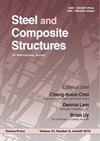Exact third-order static and free vibration analyses of functionally graded porous curved beam
IF 3.9
3区 工程技术
Q1 CONSTRUCTION & BUILDING TECHNOLOGY
引用次数: 7
Abstract
An exact solution based on refined third-order theory (TOT) has been presented for functionally graded porous curved beams having deep curvature. The displacement field of the refined TOT is derived by imposing the shear free conditions at the outer and inner surfaces of curved beams. The properties of the two phase composite are tailored according the power law rule and the effective properties are computed using Mori-Tanaka homogenization scheme. The equations of motion as well as consistent boundary conditions are derived using the Hamilton's principle. The curved beam stiffness coefficients (A, B, D) are obtained numerically using six-point Gauss integration scheme without compromising the accuracy due to deepness (1+z/R) terms. The porosity has been modeled assuming symmetric (even) as well as asymmetric (uneven) distributions across the cross section of curved beam. The programming has been performed in MATLAB and is validated with the results available in the literature as well as 2D finite element model developed in ABAQUS. The effect of inclusion of 1+z/R terms is studied for deflection, stresses and natural frequencies for FG curved beams of different radii of curvature. Results presented in this work will be useful for comparison of future studies.功能梯度多孔弯曲梁的三阶静力和自由振动精确分析
基于改进三阶理论(TOT),给出了具有深曲率的功能梯度多孔弯曲梁的精确解。通过在弯曲梁的外表面和内表面施加自由剪切条件,推导了改进后的位移场。根据幂律规则对两相复合材料的性能进行了裁剪,并采用Mori-Tanaka均质方案计算了有效性能。利用哈密顿原理导出了运动方程和一致边界条件。在不受深度(1+z/R)项影响的情况下,采用六点高斯积分法对曲线梁刚度系数(A, B, D)进行数值计算。孔隙率模型假设对称(均匀)和不对称(不均匀)分布在弯曲梁的横截面上。在MATLAB中进行了编程,并与文献中的结果以及在ABAQUS中开发的二维有限元模型进行了验证。研究了1+z/R项对不同曲率半径的FG曲线梁挠度、应力和固有频率的影响。本文的研究结果将为今后的研究提供参考。
本文章由计算机程序翻译,如有差异,请以英文原文为准。
求助全文
约1分钟内获得全文
求助全文
来源期刊

Steel and Composite Structures
工程技术-材料科学:复合
CiteScore
8.50
自引率
19.60%
发文量
0
审稿时长
7.5 months
期刊介绍:
Steel & Composite Structures, An International Journal, provides and excellent publication channel which reports the up-to-date research developments in the steel structures and steel-concrete composite structures, and FRP plated structures from the international steel community. The research results reported in this journal address all the aspects of theoretical and experimental research, including Buckling/Stability, Fatigue/Fracture, Fire Performance, Connections, Frames/Bridges, Plates/Shells, Composite Structural Components, Hybrid Structures, Fabrication/Maintenance, Design Codes, Dynamics/Vibrations, Nonferrous Metal Structures, Non-metalic plates, Analytical Methods.
The Journal specially wishes to bridge the gap between the theoretical developments and practical applications for the benefits of both academic researchers and practicing engineers. In this light, contributions from the practicing engineers are especially welcome.
 求助内容:
求助内容: 应助结果提醒方式:
应助结果提醒方式:


